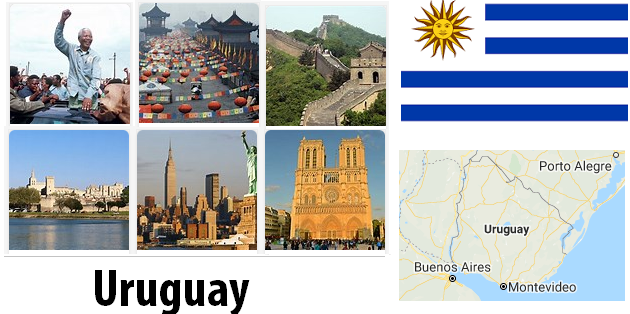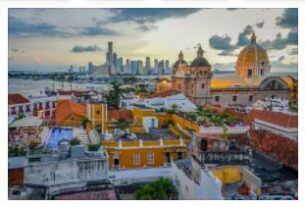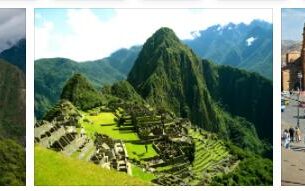The coast of Uruguay, discovered by the Spaniard Juan Diaz de Solis in 1516, was then by Caboto in 1537 equipped with a first fort in Rio San Salvador; but the Spanish occupation followed methodically only in the 17th and 18th centuries.
In previous years Spain and Portugal were always engaged in disputes over the ownership of the territories that their explorers were gradually discovering.
To prevent a real war between them, Pope Alexander VI had a Congress convened in Tordesillas, Spain, in 1494, during which it was decided to trace across the Atlantic and South America, from the North Pole to the South Pole, a dividing line: all the lands discovered and conquered to the west of this line had to go to Spain, those to the east to Portugal. The territory corresponding to today’s Uruguay belonged first to Portugal; then from the beginning of 1600 it was considered to belong to Spain with the name of “Banda Oriental del Uruguay”.
But in 1680 the Portuguese founded, in front of Buenos Aires, on Rio de la Plata (therefore in Uruguayan territory) their own base with the name of “Colonia”.
This naturally provoked violent disagreements between the Spanish and the Portuguese that lasted for almost a century. See Countryaah for population and country facts about Uruguay. Meanwhile in 1726 the Marshal of Campo Bruno de Zabala founded Montevideo, populating it with families from Buenos Aires.
It was founded as a military port with the name of “San Felipe del Puerto de Montevideo”, but the name is much older. Some want it to derive from the Latin words that Magellan uttered seeing a 150 meters high hill, which stood near the place of the present city: “Montem Video”, that is: “I see a mountain”. But the much more probable hypothesis is that the name derives from the name given by the first discoverers of the hill, namely: “Cerro (mountain) de Santo Ovidio”; this is because the Holy Ovid is very popular all over Spain.
In 1776, the King of Spain, Charles III, had defined the territory of Uruguay as “Viceroyalty of the Rio de la Plata”, included in the intention of Buenos Aires and in 1777, the Treaty of San Ildefonso, definitively assigned the “Band Oriental ”to Spain, including Cologne.
After becoming king of Spain Giuseppe Bonaparte (1806) the British made an expedition to Uruguay, led by General Whitelock, who exercised effective dominion over the city of Montevideo until 7 September 1807.
Then it returned to Spanish rule; but in 1810 the first motions for independence began, which resulted in a first revolutionary attempt in February 1811, promoted by a parish priest, Silvestro Antonio Martinez. The attempt failed.
Some time later, in 1815, he came on the scene one of the most beloved characters of American independence, Jose Gervasio Artigas; he raised the Uruguayan people and drove out the Spaniards, even with the help of a junta from Buenos Aires. But in 1817 the Portuguese entered the scene and conquered Montevideo. The province called “cisplatin”, that here de la Plata, was annexed to Brazil (1824).
Then a war broke out between Argentines and Brazilians, which ended with the Treaty of August 27, 1827, for which Uruguay, recognized independent state, assumed a liberal Constitution, July 18, 1830, effective date of the existence of the “Oriental Republic of Uruguay”.
Meanwhile two parties had formed: the “Colorados”, with red uniforms, headed by General Fructuoso Rivera, and the “Blancos”, with white uniforms, headed by Juan Lavalleja.
The first constitutional president was elected Rivera, who ruled firmly from 1830 to 1834.
In 1835 the “white” general Manuel Oribe was elected, who allied himself with the Argentine dictator Rosas and was therefore ousted and driven out (1837).
In 1838, Oribe attempted to regain power with the help of the Argentine army and besieged Montevideo, to whose defense intervened, in addition to other forces, even Garibaldi (1843/1851).
After 9 years of siege and war, the country’s internal situation was rather uncertain. There was a series of struggles between the “Colorados”, liberals, and “blancos”, conservatives, and with continuous changes of presidents for a century.
After the fall of General Aguirre (1865), one of those presidents, he began to govern energetically General Venancio Flores, who during his mandate took care to revive the state by giving impetus to the construction of railway lines, to industries related to cattle breeding, the maximum wealth of the country. He oversaw social legislation by establishing civil and trade codes; improved public education institutions.
Then he allied himself with Argentina and Brazil against Paraguay, for a border war, and was assassinated in 1869.
There was a long dark period and contrasted presidencies, and only in 1897, with the election of Lindolfo Cuestas there was a quiet period, with the dissolution of Parliament and the pacification of the two parties.
At the end of his mandate, 1903, Josè Battle y Ordonez took office, completing the social legislation with significant improvements, such as the institution of the eight-hour working day, the abolition of the death penalty, divorce, the gratuity of the primary, secondary and university education. Great impetus was given to the frozen, salted (in the saladeros), smoked or processed into preserves and extracts industry. For large breeding cattle had set up numerous “estancias”, ie farms where the cattle lived outdoors. The fed farming, since then, the wool industry and footwear, special importance for export.
During the 1st World War Uruguay broke off diplomatic relations with Germany, but falling short of an actual state of war. From this he gained significant economic benefits from France and England and the United States also increased their trade relations.
Since then the periodic presidencies followed with various events and unrest, until the advent of the “white” party against the “colorado” party, which took place in the 1925 elections.




